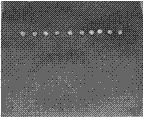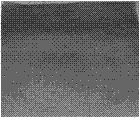Method for rapidly identifying and screening salt-tolerant materials in sorghum germination period
A technology of salt tolerance and germination period, which is applied in the field of salt tolerance screening and identification of sorghum germination period, can solve the problems of seed radicle growth messy, unintuitive results, long identification time, etc. Accurate, Controllable Effects
- Summary
- Abstract
- Description
- Claims
- Application Information
AI Technical Summary
Problems solved by technology
Method used
Image
Examples
Embodiment 1
[0055] Example 1 Salt Tolerance Experiment of Sorghum Maintainer Line BTx623
[0056] Test preparation: 500mL of seed coating agent; 10 plastic petri dishes with a diameter of 10 cm; 40 copies of wax paper of 15cm×20cm; 80 copies of germination paper of 15cm×20cm (Anke, USA); jars with a lid of 10cm in diameter 10 pieces; 1 pair of tweezers. Prepare 500ml each of 0, 100, 150, 200, 250, 300, 350, 400 and 450mmol NaCl solutions.
[0057] (1) Seed germination
[0058] Select about 500 plump and complete BTx623 seeds, and coat them with a seed coating agent. Put 50 seeds in each petri dish, add 10 milliliters of tap water, make the water surface just cover the seeds, put it in a light incubator at 28 degrees Celsius, and incubate in the dark for about 24 hours.
[0059] (2) Root cultivation
[0060] The germination paper 2 and the germination paper 3 are soaked with water. Put the wax paper 1 on the bottom layer, put the germination paper 2 on it, and use tweezers to place th...
Embodiment 2
[0069] Example 2 Evaluation of salt tolerance of 10 sorghum variety resources including BTx623 by using the salt tolerance identification method at germination stage in "Sorghum Germplasm Resources Description Specification and Data Standard"
[0070] According to the identification method of salt tolerance at germination stage in "Sorghum Germplasm Resources Description Specification and Data Standard", 10 sorghum variety resources were tested for salt tolerance. Prepare 0 (CK), 100, 150, 200, 250, 300, 350, 400 and 450 mmol NaCl solutions respectively. The experiment consisted of 1 control and 8 treatments, with 3 repetitions. Put a layer of filter paper in the petri dish, put 50 whole and plump sorghum seeds evenly into the petri dish, add 5mL of the NaCl solution of different concentrations above, cover the lid, and seal it with a parafilm to prevent water from evaporating. The petri dishes were randomly placed in the incubator, the temperature of the incubator was set at...
Embodiment 3
[0082] Example 3 Utilize 300mmol, 350mmol, 400mmol, 450mmol and 500mmol NaCl solutions to gradually screen sorghum salt-tolerant mutants
[0083] Test preparation: 500 mL of seed coating agent; 260 plastic petri dishes with a diameter of 4 cm; 520 copies of wax paper of 15 cm × 20 cm; 1040 copies of germination paper of 15 cm × 20 cm (US Anke); 10 pcs; 3 tweezers. Experimental materials: 256 sorghum mutants.
[0084] (1) Seed germination
[0085] A total of 256 copies of sorghum mutants. About 30 full and complete seeds are selected for each line, and are coated with a seed coating agent. Put the seeds of each strain into a plastic petri dish with a diameter of 4 cm, add 3 milliliters of tap water to make the water surface just cover the seeds, put them in a light incubator at 28 degrees, and cultivate them in the dark for about 24 hours.
[0086] (2) Root cultivation
[0087] The germination paper 2 and the germination paper 3 are soaked with water. Record the serial nu...
PUM
 Login to View More
Login to View More Abstract
Description
Claims
Application Information
 Login to View More
Login to View More - R&D
- Intellectual Property
- Life Sciences
- Materials
- Tech Scout
- Unparalleled Data Quality
- Higher Quality Content
- 60% Fewer Hallucinations
Browse by: Latest US Patents, China's latest patents, Technical Efficacy Thesaurus, Application Domain, Technology Topic, Popular Technical Reports.
© 2025 PatSnap. All rights reserved.Legal|Privacy policy|Modern Slavery Act Transparency Statement|Sitemap|About US| Contact US: help@patsnap.com



